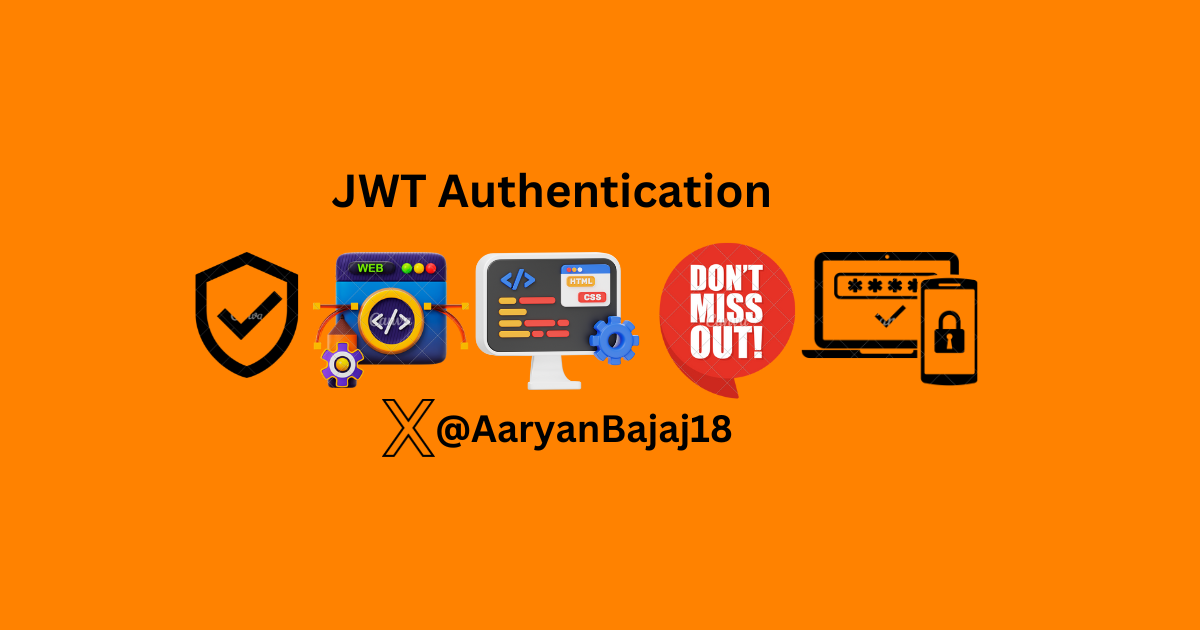Understanding JWT Authentication: A Real-Life Analogy
 AARYAN BAJAJ
AARYAN BAJAJ
Introduction
In the ever-evolving landscape of web development, ensuring secure communication between client and server is paramount.
One of the most popular methods for achieving this is JWT (JSON Web Token) authentication.
But what exactly is JWT, and why is it so widely used? In this blog, we will demystify JWT authentication using an engaging real-life analogy, making the concept easy to grasp and understand.
What is JWT?
JWT, or JSON Web Token, is an open standard (RFC 7519) for securely transmitting information between parties as a JSON object.
This information can be verified and trusted because it is digitally signed.
JWTs can be signed using a secret (with HMAC algorithm) or a public/private key pair using RSA or ECDSA.
Real Life Example : The Concert Ticket

Imagine you’re attending a concert. When you purchase a ticket, you receive a pass that grants you access to the event.
This pass contains specific information like your name, seat number, and a unique barcode.
At the entrance, the security scans your ticket to verify its authenticity.
Once inside, you can move around without having to show your ticket repeatedly.
In this analogy:
Ticket: The JWT token.
Information on the Ticket: The claims within the JWT, which could include user details and permissions.
Unique Barcode: The signature that ensures the ticket (JWT) is genuine.
Security Scanning the Ticket: The server verifying the JWT.
How JWT Works
User Authentication: When a user logs in with their credentials, the server authenticates the credentials.
Token Creation: Upon successful authentication, the server generates a JWT, which contains a payload (user information and claims) and signs it using a secret key.
Token Transmission: The JWT is sent back to the client (usually stored in local storage or a cookie).
Token Usage: For subsequent requests, the client sends the JWT in the authorization header.
Token Verification: The server verifies the token's signature and extracts the payload to authorize the request.
Advantages of JWT
Stateless: JWTs are stateless, meaning the server does not need to store session information.
Compact: The JWT format is compact and easy to transmit via URL, POST parameters, or inside HTTP headers.
Self-Contained: JWTs contain all the necessary information, reducing the need for database queries.
Real Life Application : Online Shopping

Consider an online shopping scenario. When you log in to your account, the server generates a JWT for you.
This token is your "shopping pass." As you browse through the site, add items to your cart, and proceed to checkout, the JWT is sent with every request, allowing the server to verify your identity and permissions without asking you to log in again.
This seamless experience is made possible by JWT authentication.
Conclusion
JWT authentication provides a secure and efficient way to handle user authentication in modern web applications.
By understanding JWT through the lens of real-life examples like concert tickets and online shopping, it becomes clear how JWT simplifies the process of authenticating users and securing communication between client and server.
Implementing JWT in your application can lead to enhanced security and a smoother user experience.
Thank You Everyone For The Read
Share it with your dev Friends ...
Subscribe to my newsletter
Read articles from AARYAN BAJAJ directly inside your inbox. Subscribe to the newsletter, and don't miss out.
Written by

AARYAN BAJAJ
AARYAN BAJAJ
Hi Everyone 👋🏻 , I'm Aaryan Bajaj , a Full Stack Web Developer from India(🇮🇳). I share my knowledge through engaging technical blogs on Hashnode, covering web development.